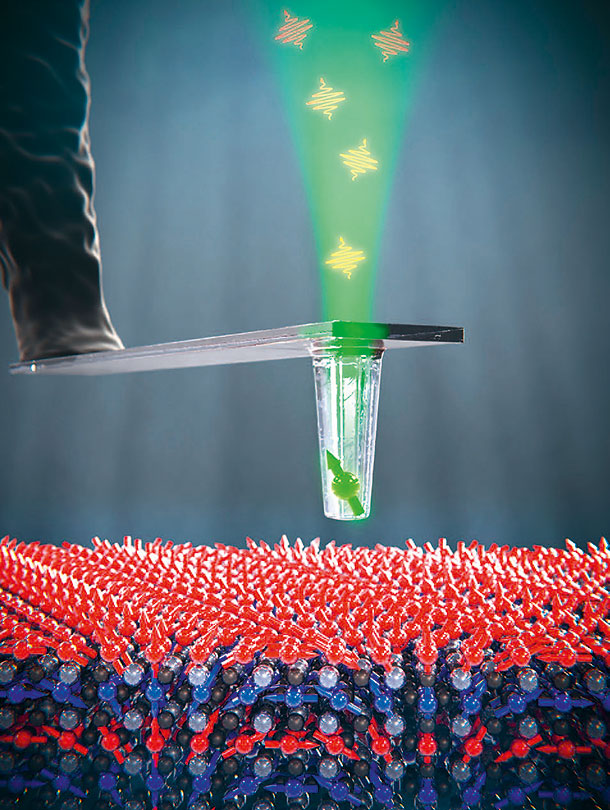Quantum sensors revolutionize microscopy.
Text: Christel Möller
While quantum computers are still a thing of the future, the application of quantum-based sensors is already a reality. Physicists based in Basel have developed extremely sensitive sensors that are able to provide images at an unprecedented resolution.
For their research, Martino Poggio and his team use the special properties of nanowires to develop innovative sensors capable of measuring electric fields, forces, charges, and spins. Nanowires are extremely thin, elongated crystals with an almost faultless lattice. With a diameter of around 100 nanometers, they are almost a thousand times thinner than a human hair. They come in different shapes and sizes for different applications, have a very low mass, and have a huge surface area in relation to their volume. In addition to nanowires etched or milled from solid blocks of material, Poggio also works with wires that assemble themselves from their molecular building blocks.
Nanowires for diverse applications
These self-assembling nanowires have a special geometry that means they can be used in, for instance, atomic force microscopy to establish both the size and direction of electric fields. Due to their mechanical properties, the nanowires vibrate along two perpendicular axes with roughly the same frequency when the surface is scanned. If an electric field acts on the sensor, it alters the vibration of the two axes. The atomic force microscope developed by Poggio’s team can monitor the two perpendicular lines and use the changes in vibration to produce an accurate picture of a sample’s force.
With another type of nanowire, the physicists deliberately integrate quantum dots, which are also known as “artificial atoms” because of their resemblance to actual atoms. At between 10 and 100 nanometers in size, quantum dots are much larger than natural atoms and have an adjustable number of electrons that have limited freedom of movement. When excited by a laser, quantum dots emit individual light particles (photons) with similar wavelengths. If heat or an electric field causes the nanowire to vibrate, this creates mechanical tension in the quantum dot and thus changes the wavelength of the light it emits. “By measuring the wavelengths, we can determine the movement and position of the nanowire with an unprecedented sensitivity of just 100 femtometers,” explains Poggio. For comparison: 100 femtometers corresponds to 10-15 meters or a quadrillionth of a meter.
Scientists in the Argovia professor’s lab apply these sensitive sensors to analyze tinyelectrical andmagnetic fields. It may also be possible to place several quantum dots on one nanowire, to use the motion to link them together and so pass on quantum information.
Imperfect diamonds
Like his colleague, Patrick Maletinsky is also directing his research activities toward a nanostructure – one in which individual electrons are “trapped” and which can be used as a quantum sensor. He uses special diamonds that have natural defects in their crystal lattice. At two neighboring points in the lattice, a carbon atom is replaced by a nitrogen atom, and there is a gap in the direct vicinity. This type of defect – known as a nitrogen-vacancy center – contains single, circling electrons that can be excited and manipulated.
Maletinsky’s team are integrating these NV centers into tiny diamant tips of several 100 nanometers for atomic force microscopes. When excited by external electric or magnetic fields, the electron spin of the free electrons in the nitrogen-vacancy center changes. The scientists use a sophisticated opticalmeasurement method to measure the change in spin, which provides them with a picture of the acting field at a resolution of just a few nanometers.
“We primarily use the sensors to investigate new materials and their magnetic properties,” explains Maletinsky. The quantum method has allowed Maletinsky to raise the sensitivity of the measurements by one or two orders of magnitude over conventional methods. He can now image magnetic fields that were previously invisible. The diamond sensors can be used at room temperature and at temperatures close to absolute zero. This is important when investigating superconductors, for instance, as their particular properties only emerge at around –200°C. The sensors can also be used to analyze biological samples because the diamonds do not interact with biological material and can be used at room temperature.
Bringing quantum sensors to the market
To make the multipurpose diamond sensors available to other research groups and users, Maletinsky and Dr. Mathieu Munsch, a former postdoc at the Department of Physics, founded a startup called Qnami in early 2016. “Qnami produces the highly sensitive sensors, advises customers from research and industry, and responds to individual requests,” says Maletinsky, describing his startup. There are also plans to develop a complete atomic force microscope equipped with diamond sensors. This will significantly increase the number of potential Qnami customers.
The development of sensors based on the laws of quantum mechanics would not have been possible without advances in our understanding of the quantum world. The new sensors will revolutionize microscopy, pave the way for other exciting applications, and help advance the development of the quantum computer.
More articles in the current issue of UNI NOVA.

